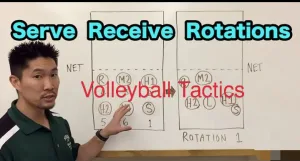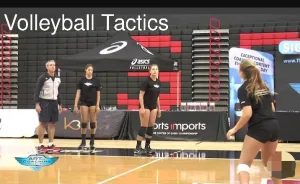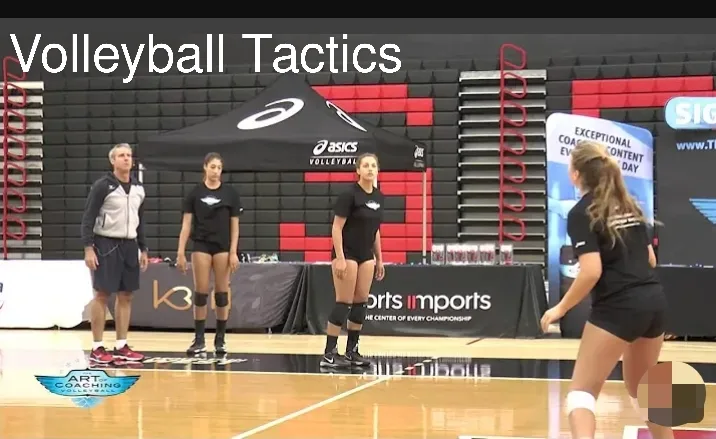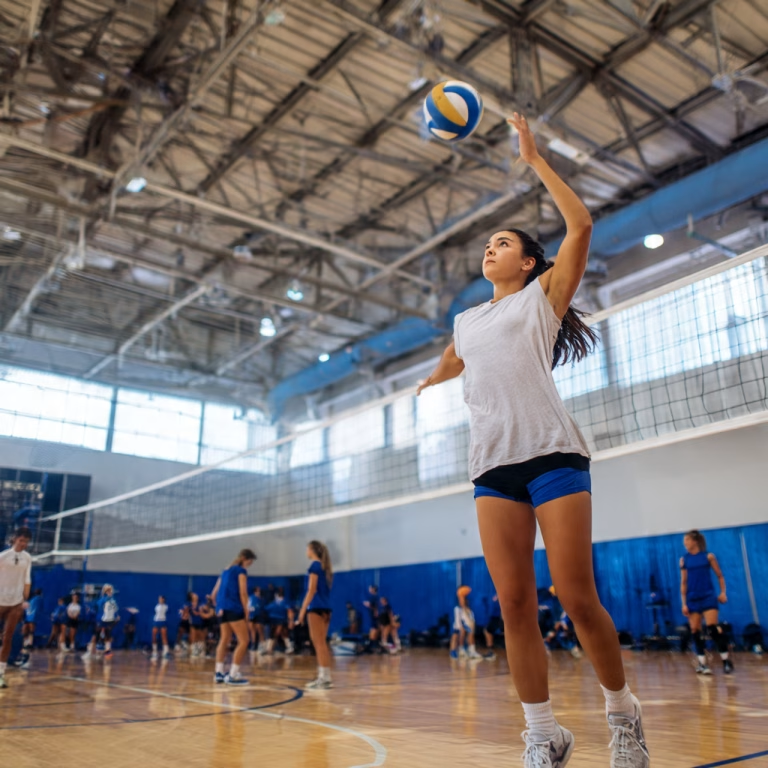When it comes to volleyball, winning isn’t just about raw power or individual skills—it’s about mastering volleyball tactics. Whether you’re a casual player or part of a competitive league, understanding and implementing effective tactics can drastically improve your game.
Importantly, these tactics are not static; they can and should be adapted during the game based on the evolving dynamics on the court.
Broadly speaking, volleyball tactics can be categorized into two main types: offensive and defensive. In this article, we will explore the strategies that teams employ during both the attack and defense phases.
Let’s also look at the essential and advanced volleyball tactics that can help you outsmart your opponents and dominate the court.
Understanding volleyball tactics
Volleyball tactics are the strategies and plans that teams use to outplay their opponents. These tactics involve everything from how you serve and position yourself on the court to how you communicate with your teammates. In volleyball, even the smallest tactical adjustments can make a big difference in the outcome of a match.
See Also: Volleyball Referee Signals Everyone Should Know
11 Best Volleyball tactics

1. Effective Communication:
Volleyball is a team sport that relies heavily on constant communication among players. From deciding who will take the ball to discussing serving tactics, effective communication is a critical aspect of the game.
Tactic: Ensure your team is comfortable with open and clear communication. Develop a set of standard calls and signals that everyone understands. As you advance, you can even use misdirection and coded messages to confuse your opponents and gain a strategic advantage.
2. Serving Tactics
Serving is one of the few moments in a volleyball game where you have full control over the ball. A well-placed serve can set the tone for the entire rally.
- Vary Your Serves: To keep your opponents off balance, mix up your serves. Use a combination of float serves, jump serves, and topspin serves. For example, after a few fast serves, try a soft float serve to throw off the receiver’s timing.
- Target Weak Spots: Identify the weaker passers on the opposing team or aim for gaps in their formation. A common tactic is to serve between two players, forcing them to communicate and often leading to errors.
See Also: How to Get Better at Volleyball: Practical Tips
3. Offensive Tactics
A strong offense is about more than just spiking the ball as hard as you can. Effective offensive tactics involve a mix of power, placement, and deception.
- Mix Up Your Attacks: Just like with serving, variety is key in attacking. Use tips, roll shots, and cross-court hits to keep the defense guessing. For example, after a few hard spikes, a well-placed tip over the blockers can catch the defense off guard.
- Positioning is Crucial: Position your hitters to exploit weaknesses in the opponent’s defense. If you notice that their middle blocker is slow to react, have your setter aim more quick sets to your middle hitter.
Other offensive strategies commonly used in modern volleyball.
- The Wave: This combination involves two attacking players working in tandem. After a pass from the setter, the first attacker makes a move as if to hit, drawing the block. However, they let the ball pass by. As the defenders come down from their block, the second attacker—timing their jump perfectly—strikes the ball, often with little resistance. The coordinated motion of the players resembles a wave, hence the name.
- The Pipe: Similar to the wave, this tactic involves a player attacking from the back row. As the ball reaches the setter, the first attacker makes a feigned swing, drawing the block, while the actual attack is carried out by a player from the sixth zone, who times their approach perfectly to strike the ball from behind the front line.
- The Cross: In this combination, the first attacker jumps as if preparing for a quick set, drawing the blockers. Meanwhile, another attacker runs behind them, moving in the opposite direction. The setter then delivers the ball to this second attacker, who hits the ball into the open space created by the decoy movement.
4. Defensive Tactics
In volleyball, a strong defense can be just as effective as a powerful offense. Good defensive tactics prevent the opposing team from scoring and create opportunities for your team to transition into attack mode.
- Block and Dig with Purpose: Focus on reading the opponent’s hitters to anticipate where the ball will go. Position your blockers to cover the most likely attack angles and have your diggers ready to cover the rest. For instance, if an opponent consistently hits cross-court, align your defense to counter that shot.
- Transition Quickly: After a successful dig or block, quickly transition into an offensive setup. This means your setters and hitters should be ready to attack as soon as the ball is passed.
Other Strategies
Upcourt Defense Tactics: In this system, the libero positions themselves near the center of the attack line. From this vantage point, the libero is tasked with covering a wide area, receiving balls directed in various directions. Meanwhile, the players in the fifth and first zones position themselves closer to the court’s edges, responsible for guarding the sidelines and retrieving balls following an attack or block.
Backcourt Defense Tactics: Here, the libero positions themselves near the end line, ready to handle powerful attacks, deflections, and block rebounds along the backline. The players in zones five and one step slightly forward, focusing on covering hits along the sidelines and handling deflections.
In both defensive systems, the front-line players—positioned in zones two, three, and four—focus primarily on setting up an effective block to disrupt the opponent’s attack.
5. Positional Play and Rotation
Understanding the roles of each position on the court and maintaining proper rotation is key to a well-coordinated team.
- Know Your Role: Whether you’re a setter, libero, or outside hitter, understanding your responsibilities at every rotation is crucial. This knowledge helps you anticipate where the ball will go and ensures you’re always in the right place at the right time.
- Strategic Rotation: Use the rotation system to your advantage by positioning your best blockers against the opponent’s strongest hitters or ensuring your best server rotates to the serving position during crucial points.
6. Team Coordination
In a fast-paced game like volleyball, coordination is essential. Clear and effective coordination helps prevent errors and ensures everyone on the team is on the same page.
- Develop Standard Calls: Establish a set of signals and calls that everyone on the team understands. For example, use specific terms to indicate who will take the ball, what kind of set is coming, or where to position for defense.
- Use Misdirection: As you become more advanced, incorporate misdirection into your communication to confuse the opponents. For example, you might signal for a quick set but then deliver a high ball to the outside hitter.
7. Rotation Tactic:
Understanding the rotation system in volleyball is crucial, especially at higher levels of play. It’s important not only to follow the rules but also to ensure that the right players are in the right positions at the right time.
Tactic: Be aware of your team’s rotation order and your positional responsibilities in each rotation. This includes knowing when you should be preparing to serve, attack, set, or defend. A strategic rotation can help match your best blockers against the opponents’ strongest hitters or ensure that your best setter is always setting up the attacks.
8. Transition tactic:
In volleyball, teams must continuously switch between offense and defense. Mastering these transitions can give your team a significant edge.
Tactic: Focus on quickly transitioning from defense to offense after a successful dig or block. This includes getting into position for an attack as quickly as possible and having the setter ready to set up the hit. Conversely, after attacking, players should immediately prepare to defend against the opponent’s counterattack.
9. Substitution Tactic:
In volleyball, teams can make substitutions to alter their lineup during a game. Using substitutions strategically can help you adapt to the flow of the game and counter your opponent’s tactics.
Tactic: Use substitutions to give tired players a rest, strengthen your team in certain rotations (such as bringing in a stronger server or blocker), or disrupt the opponents’ rhythm. Keep in mind that substitutions are limited, so use them wisely.
10. Scouting and Adjusting to Opponents:
One key to successful volleyball tactics is the ability to adjust your approach based on your opponent’s strengths and weaknesses.
Tactic: Observe the other team’s tactics, player tendencies, and any patterns you notice in their play. Use this information to adjust your tactics, such as changing your serving targets, modifying your blocking strategy, or exploiting gaps in their defense.
11. Mental tactic:
Finally, volleyball is as much a mental game as it is physical one. Staying focused, composed, and confident can significantly impact your performance.
Tactic: Develop routines to help you stay focused during games, like a specific pre-serve routine or a team cheer. Additionally, work on maintaining a positive attitude, supporting your teammates, and not getting discouraged by mistakes or losses.
See Also:
- 20 Words Related to Volleyball That Every Fan Should Know
- Volleyball Violations and Mistakes
- Volleyball Strategies for Small Teams
Advanced volleyball tactics

Misdirection and Deception
At higher levels of play, misdirection can be a powerful weapon. This involves faking one move and executing another, keeping the opponents guessing.
- Fake Sets and Attacks: A setter might jump as if setting the ball to one hitter but instead set it to another. Similarly, hitters can approach the net as if preparing for a hard spike but then execute a soft tip over the blockers.
Analyzing Opponents
A critical aspect of volleyball tactics is the ability to analyze your opponents and adjust your strategies accordingly.
- Scout the Competition: Pay close attention to the opponent’s playing style during warm-ups and the early stages of the match. Identify any patterns in their attacks, serves, and rotations.
- Adjust Your Strategy: If you notice a particular hitter consistently going for cross-court shots, adjust your defense to cover that angle. Similarly, if the opponent struggles with a specific type of serve, exploit that weakness.
Frequently Asked Questions (FAQs) About Volleyball Tactics
Q1: What is the most important tactic in volleyball?
The most important tactic in volleyball is effective communication. Without clear communication, even the best players can make mistakes, leading to missed opportunities and points for the opposing team. Establishing standard calls and ensuring everyone on the team understands their role can significantly improve overall team performance.
Q2: How can I improve my serving tactics?
To improve your serving tactics, practice varying your serves. Work on different types of serves—like float, topspin, and jump serves—and focus on accuracy. Aim for weak spots in the opponent’s formation or target specific players who struggle with serve reception. Consistent practice and understanding when to use each type of server can make you a more effective server.
Q3: What should I focus on when analyzing my opponent’s tactics?
When analyzing your opponent’s tactics, focus on their attacking tendencies, defensive setup, and serve reception. Look for patterns, such as whether they favor cross-court or down-the-line attacks, and adjust your defense accordingly. Also, take note of any weaknesses, such as a player who struggles with certain types of serves or a tendency to leave gaps in their formation.
Q4: How do I maintain my mental focus during a volleyball game?
Maintaining mental focus during a volleyball game involves developing routines that help you stay centered. Before each serve, take a deep breath and visualize the serve going exactly where you want it. If you make a mistake, quickly refocus on the next play instead of dwelling on the error. Additionally, staying positive and encouraging your teammates can help maintain a strong mental game.
Q5: What role does rotation play in volleyball tactics?
Rotation plays a crucial role in volleyball tactics by ensuring that each player covers the right areas of the court and matches up against the appropriate opponents. Strategic rotation can position your strongest blockers against the opponent’s best hitters or ensure that your top server is in position during critical moments of the game. Understanding and mastering your role in each rotation is essential for executing effective tactics.




